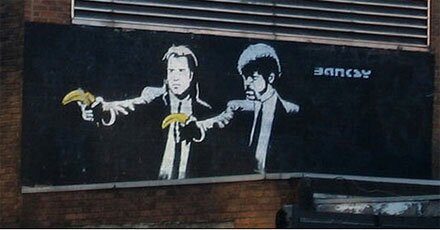
Once perceived as the scorn of urban areas, graffiti at its best has resulted in murals that transform dull architecture and even derelict neighborhoods and decrepit walls into vibrant & appealing spaces.
Graffiti is a tradition that reaches into the annals of history. Ancient Rome was rife with it, offering social commentary, satire and a reflection of the times. One graffito near Palatine Hill in Rome, the Alexamenos graffito, is believed to be the earliest known pictorial representation of the crucifixion of Jesus. Of such significance to Rome’s history, its graffiti was brilliantly brought to life by A52 in the title sequence for HBO’s series Rome.
Where as modern graffiti can truly serve aesthetic needs, its ancient counterpart appeared to lack the same lofty aesthetics. Perhaps it wasn’t as necessary in prominent cities abundant with ornate architecture and cobbled streets. Our modern urban areas maybe cleaner & more practical, but these concrete and asphalt jungles too frequently suffer from banality.
Granted graffiti has long been accused of producing “an atmosphere of social decay and neglect”, its artists subjected as criminals. A preponderance on uninspired writing in modern graffiti, amateurish chaotic scrawls, gang communications and misguided placement, lends credence to this argument. Subjective material in today’s uptight politically correct climate adds to the issue. It is understandable why local authorities would paint over or clean away such work.
However when the work is of such supreme excellence, when it clearly revitalizes an area, and its destruction produces a deterioration of the space, it is the local authorities that have committed a crime. Produced an urban tragedy.
Throughout England, the destruction of art by famed artist, Bansky, captures this disturbing trend. One that has shown a level of sheer ineptness and ignorance by local authorities. The common rebuttal that neither the cleaners, councils or organizations are professional art critics only serves to highlight their idiocy.
Several years ago London Underground workers painted over a renowned “Pulp Fiction mural visible near Old Street Tube station”, of Jackson & Travolta holding bannanas instead of guns. A mural that made a highly visible, yet ugly section of an ugly building, interesting. Its replacement, an unsightly black swath.
Ironically, several other less desirable graffiti appeared in its place, continually painted over, forming a dialog via architecture. From a request to bring back Bansky to an anti-terrorism scrawl and a philosophical comment ” with a poor sense of scale”, that declared “Nothing Lasts Forever”.
In another tragic incident, workmen hired by the infamously incompetent Hackney Council, began painting over a Bansky mural on private property in Stoke Newington, East London, despite pleas to cease from the property manager. Their initial response, “The council’s position is not to make a judgement call on whether graffiti is art.” It was later added, “Due to a problem at the land registry, unfortunately our letters stating our intention to clean this building didn’t reach the owner.”
The mural, commissioned by the band Blur for their 2003 single Crazy Beat, apparently “attracted tourists from all over the world and become a local landmark”. Its destruction possibly resulting in lost tourism revenue for the borough and leaving an uninviting black blight in its wake.
As the demolition of Penn Station spurred a historical preservation movement, it seems graffiti now needs its own preservation movement.







Images 1 - 5 | Bansky. Image 5 photographed by Richard Cocks via Flickr.
Image 6 | El Mac with Retna featuring Jolie Robinson.
Image 7 | El Mac with Reyes. Photography by FunkandJazz.
Image 8 | Unknown.









